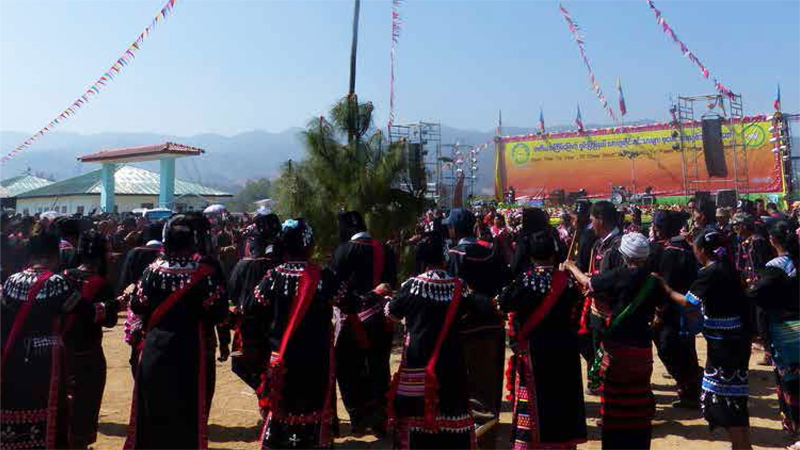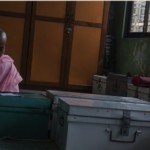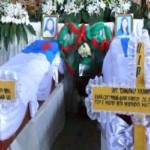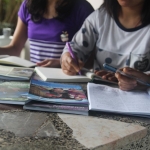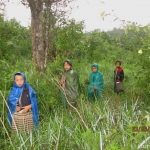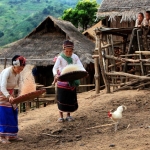Ariana Zarleen / Mizzima, April 3, 2015
KYAINGTON, SHAN STATE – In the mountains of eastern Shan State, the Lahu are among the many ethnic groups who continue their traditional farming lifestyle in largely inaccessible remote mountain villages.
Lahu suffer from a disproportionate lack of education and development. As most Lahu live in remote villages, they often have restricted access to any services, including education. Most villagers are illiterate, traditional medicine is used widely, infrastructure is non-existent and there is limited access to electricity or water, say local activists.
The area around Kyaington, the main city in eastern Shan State, is surrounded by ethnic villages, some of them Lahu, and all are at least partly under government control. The Lahu have no army to protect them, and instead, many Lahu have joined militia groups that are directly under Tatmadaw control.
Local NGOs face double jeopardy when conducting training in the area as they say they fear not only the government but also their own people. Mary, a veteran Lahu politician and member of the Shan State parliament, told me there was no big Lahu political movement because of a lack of education.
Lahu people do not feel equal to other ethnic minorities, Mary told me in the living room of her home in Pan Lin village.
“Some Lahu people have difficulties as they look down on themselves in relation to other ethnic people, because other people are more educated and richer than them,” she said.
De Paw La Bo, a young Lahu woman who works for a local Lahu group and regularly conducts training, echoed Mary’s views. “Lahu people is lack of education,” she said in English. “They do not have a chance to study like other ethnic people.”
Lack of education
Isolated communities and widespread poverty create barriers for the Lahu to access education. In some remote Lahu villages, there are schools but no teachers, De Paw La Bo told me quietly in her office. The government sometimes expects poor villagers to pay for the teacher’s salary, she said.
Many Lahu people have no means of earning an income and are certainly unable to contribute towards anyone else’s salary. Most villagers farm rice and vegetables for their family’s survival. Some sell farm produce in towns, but for isolated villages four or five hours from the nearest town, accessing markets is hardly an option.
During a visit to Pan Lin, only an hour from Kyaington, I am told it is much more developed than remote communities. Houses in Pan Lin have tin roofs, the school has teachers and some of its pupils have study materials such as books, pens and school bags.
Na Ga, 60, is one of the Lahu residents of Pan Lin who grows her own food. Although her family has enough to eat, generating income is a significant challenge. “Very difficult,” she said when asked about making a living. “We cannot sell our products because we have no communication with other people.”
Na Ga had 10 children, of whom seven survived childhood. She has found ways to support her children to go to school, doing day labour for others. “Sometimes we go find something in the forest and sell it in the village,” she added.
Calling for more support
In a discussion with De Paw La Bo and her colleague, Eh Na, at their office, I realise that the locals are sometimes confused about the origin of the support provided to Lahu villagers.
Eh Na believes that the study materials for Lahu children came from the government but De Paw La Bo was quick to correct her that they were provided by the United Nations Children’s Fund, UNICEF. “Not government,” said De Paw La Bo. “Government didn’t support anything.”
The two women also explained that the support reaches a fraction of the children and only those living near townships. De Paw La Bo laughed at the memory of her nephew proudly showing a UNICEF school bag that only three other children had received in his village. She also laughed when asked if Lahu villages have electricity.
NGO-backed educational initiatives are also accessibly only near the towns, the women said. “Lahu people need to give a lot of knowledge,” said De Paw La Bo. “But now I see most NGO they go and they give
In Kyaington, U Ye Sheh, the chairman of the Lahu National Development Party in the area, shares many of the women’s opinions.
He receives no salary for his work and the money he earns managing a farm supports his political activities.
“I want to say to the world please help our Lahu people in order to improve their education level,” said U Ye Sheh, who lives in a modest house and was the only one of eight siblings to receive an education.
Freedom from fear
Mary said a lack of education was one reason why the Lahu do not have a big political movement. “The current Lahu situation is that some Lahu people are afraid of participating in politics and not brave because they are uneducated,” she said.
“If others come and train Lahu people to have more confidence and courage to work for the Lahu people, they will also be free from fear to participate in politics,” Mary said.
Mary, who has been a member of the LNDP for 25 years, said she is the only Lahu woman in the 139-member Shan State parliament.
As a woman and a member of an ethnic minority, Mary has faced significant challenges during her long career. “I was told that ‘you are just a woman involved in politics and you can be captured and tortured,’” she said. Despite repeated threats and fears for her life, Mary never gave up the struggle.
In recent years, she has found more freedom to speak and write, although concerns remain. “We cannot do what we want to do if the ruling body doesn’t allow, like now even though they say we have democracy, they still constrain the power and oppress the people because they don’t rule it as a democratic country.”
U Ye Sheh has learned to let go of his fears. “I am not afraid [to participate in politics] because I work and stand for justice,” he said.
Personal sacrifice
De Paw La Bo, who conducts training in Lahu villages, said security is a major concern for her and her colleagues.
They have no protection and because they fear both the Tatmadaw and the Lahu militia providing political training can be nerve-wracking. “For security now we are not only afraid [of the government] but also we have to be afraid of our Lahu military, militia. Because Lahu militia already cooperate with the government,” De Paw La Bo said.
“We are worried, this a bit dangerous for security. But now is a bit better than before, a little bit better than before but we are still afraid when we give training or something like this,“ she said.
De Paw La Bo said Lahu militia sometimes attend their training, watching silently and creating anxiety among the trainer and the participants. “So this time we [are] still afraid [of] these two groups of people, not only government but also each other ethnic armed group… Really afraid.”
Despite the fear, and the loud objections that De Paw La Bo hears from her family against taking part in activities that compromise her security, this determined young woman continues her mission to share her knowledge.
Mary is also determined to continue her work. “We have to sacrifice our times with all that we have to lift up our Lahu people if we really want to work for our people. Nobody can work for the well-being of their own people without sacrifice.”
The world of the Lahu
The Lahu ethnic group is believed to have originated in China and lives in villages scattered throughout mountainous areas of China, Myanmar, Laos and Thailand. There are several subgroups of Lahu, including the Lahu Na, Lahu Shi Ba Lan, Lahu Ban Keo, Lahu Nan Keo, and Lahu Ku Lao, each with their own traditional dress. Most Lahu are animist and even those who are Christian and Buddhist often mix their religious beliefs with traditional animist practices. Lahu throughout the four countries speak Lahu and can usually understand each other, although dialects vary. Birth dates are often unknown and birthdays are not celebrated. Instead, Lahu people get together for the most important celebration across the regions, the Lahu New Year, held at different times in different countries, but revered all the same.
The most important celebration
The most important celebration for the Lahu is the Lahu New Year, which is often celebrated at different times not only throughout countries but also from village to village.
In Pan Lin, the villagers celebrated for seven days during the first week of January, while most villages in the area placed the special day on January 20. In Kyaington, the three-day celebration was held from January 27 to 29.
Lahu New Year is one of the only times each year that Na Ga, a Lahu farmer in Pan Lin, leaves her village. “I go to Kyaington maybe once a year, especially for the New Year to dance,” she said, adding that her husband is one of the leading dancers in her village. This year, it was Na Ga’s turn to provide the costly pig for the village’s New Year feast and she did not make her annual trip to town.
U Ye Sheh, the Lahu National Development Party’s leader in the Kyaington, remembers celebrating New Year in the town since he was a child. He was hoping to be involved in the organising committee this year but was not allowed. It is because “they are afraid of politics,” he said.
U Ye Sheh said Lahu New Year is a special time for everyone to come together and celebrate the ending of the old year and the beginning of the new.
Although the celebration has different meanings to different people, “the Lahu pancake (made of sticky rice) and pork is compulsory,” U Ye Sheh said.
Other similarities across families and regions include traditional dancing, rituals to show respect to elders and forgiving mistakes.
In Kyaington, Lahu militia was a conspicuous presence during the three-day celebration, walking through the crowds and sometimes participating in activities such as gambling. The militia is under the command of the Tatmadaw, which has camps in villages throughout the area, including at Pan Lin.
“Last year in New Year, also there was fighting over there, under the mountain range,” U Ye Sheh said, pointing at nearby peak from his living room window. Lahu people are often trapped in conflicts between the many armed groups in the area, sometimes even during their most important celebration of the year.
*The names of some people in this article have been changed to protect their identity.
(Ariana Zarleen is a co-founder of Burma Link, a non-government organisation based in Mae Sot, Thailand, that works to amplify the voices of Myanmar’s ethnic nationalities and displaced people).
This article originally appeared on Mizzima on April 3, 2015.

